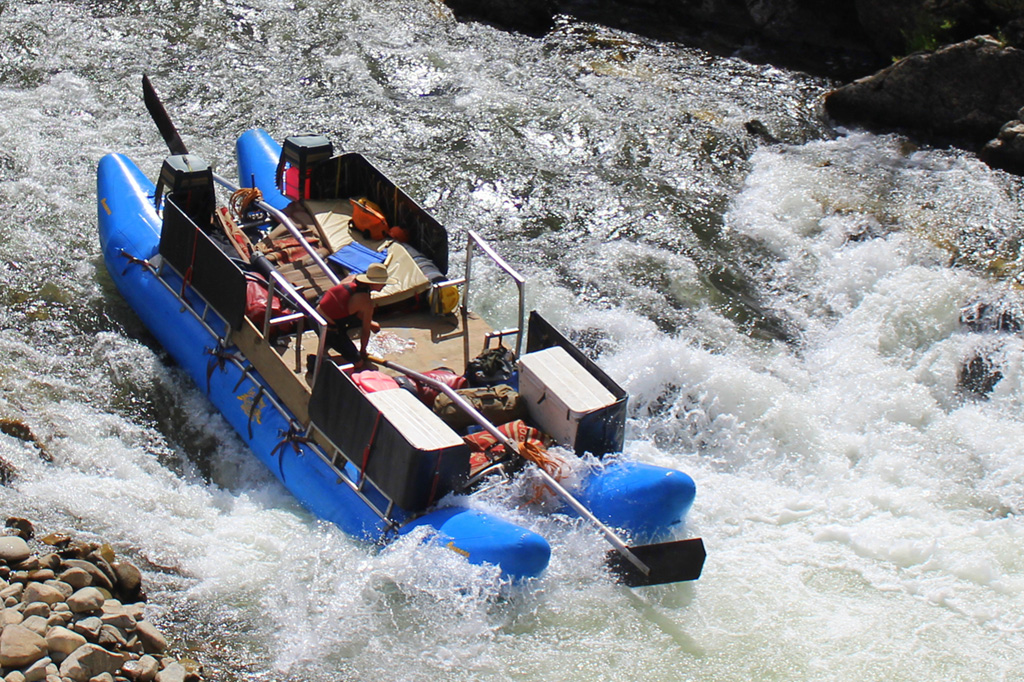A young couple stands on the bank above the Boundary Creek put-in for the famed Middle Fork of the Salmon in the River of No Return Wilderness. Pointing at a large, heavily laden boat with enormous pontoons piled high with gear bags, camp supplies, coolers, and cooking equipment. Two long arms jut incongruously out in front of the bow and behind the stern with oddly shaped wooden paddles at the end of each.
“What is that thing?” one of them asks.
“That’s a sweep boat,” the friendly guide replies as a man jumps nimbly onto the boat and springs over numerous gear bags and coolers. They watch as he adjusts his wide-brimmed hat and sunglasses over a deeply tanned face, puts on a pair of heavy-duty leather work gloves and grabs one of the large arms with each hand. There’s the faintest hint of a smile on his face as he barks instructions at the other guides from on top of the lumbering behemoth. With a certain amount of reverent celebration, the rest of the guide crew help push the giant sweep boat into the current, wishing the captain luck with a series of hoots and salutes.
“I’ve never seen anything like it,” the couple says in unison as the captain begins to dance a subtle two-step around the boat’s small wooden platform, wielding the giant arms with precision and grace as he eases the boat slowly into the current.
“Well, that’s because the only place sweep boats exist are right here in Idaho on the [Middle Fork of the] Salmon River,” the guide explains, wishing the sweep captain a smooth run through “Murph’s Hole,” a rapid less than a mile downstream that has flipped more than one of these giant sweep boats. He continues: “It’s actually because of sweep boats that this wilderness area and the [Main] Salmon River became known as ‘The River of No Return.’ Nowadays, there are only about 35 sweep boat captains in the entire world, and they all work right here on the Middle Fork.”
In the mid-late19th century, mining was the main industry in the rugged terrain surrounding the Salmon River. With no roads, the only way to get supplies to the remote mining camps and towns along the river was either by packhorses over extremely difficult and treacherous trails, or by boat down the river. Lumber was in high demand, but due to the Salmon River’s many twists, turns and rapids, simply floating logs downstream was impossible.
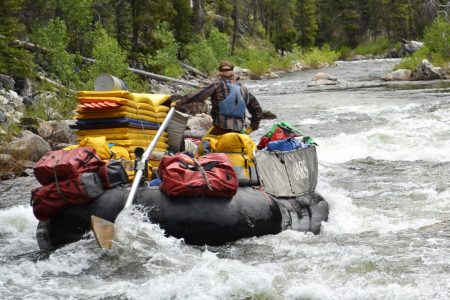
Ned Perry, sweep driver for OARS, finds his line just below the Boundary Creek launch. Photo courtesy OARS / Ashley Peel
In time, men with experience on the Mississippi River came into the area and introduced flat-bottomed boats capable of carrying extremely heavy loads with shallow drafts. These original sweep boats were called scows. They were large boats with flat bottoms built entirely out of wood. Typically around 30 feet long and 8 or 9 feet wide with 4-foot sides, the scows were designed to transport food and supplies along with mining equipment down the swift moving Salmon River from the end of the road through the jagged 5,000-foot canyon. The boats were controlled, or driven, by a long “sweep” on each end of the boat and were capable of carrying several tons of cargo. Two men, standing at either end of the boat operated the sweeps in tandem to maneuver the scow down the river. Once these boats reached their destination, whether that was the small town of Riggins, Idaho, or a mining camp along the banks of the river, they were quickly disassembled, and the lumber was sold and reused to build cabins or any other structure or equipment necessary. Thus, once these uniquely shaped supply boats headed down the river, they never returned, and the moniker, “River of No Return,” was born.
The most famous sweep scow boat captain from those early years was a man named Harry Guleke. Known as one of the best boatmen the Salmon River has ever seen, he completed as many as 200 hundred trips down the River of No Return beginning with his first trip in 1896. He once navigated a sweep boat all the way from Idaho to Portland, Oregon, along the Salmon, Snake and Columbia rivers. As his reputation grew, he made a business of taking people down the river, charging upwards of $1,000 per person, equivalent of roughly $10,000 today, a good deal more than the current cost of a commercial trip.
By the end of the 1930s, the wooden, lumber bearing River of No Return scows had been largely replaced by new roads and rubber rafts. The gold rush was long passed and all that remained were a few family ranches, some hermit’s cabins and a ghost town or two.
In 1927, Henry Weidner led a canoe trip down the Middle Fork of the Salmon, filming the trip for a documentary, which was the first known descent of the mighty Salmon’s most beautiful and scenic tributary. Other boaters followed in the mid to late 1930s. Road access did not reach the mouth of the Middle Fork until the late 30s. Before then, any float down the Middle Fork needed to continue all the way down the Main Salmon to Riggins. When a road was constructed from Stanley to Dagger Falls in the late 1950s it removed the necessity of navigating the narrow and tricky upper section of the river called Marsh Creek, along with the terrifying Dagger Falls rapid, which required a daunting portage.
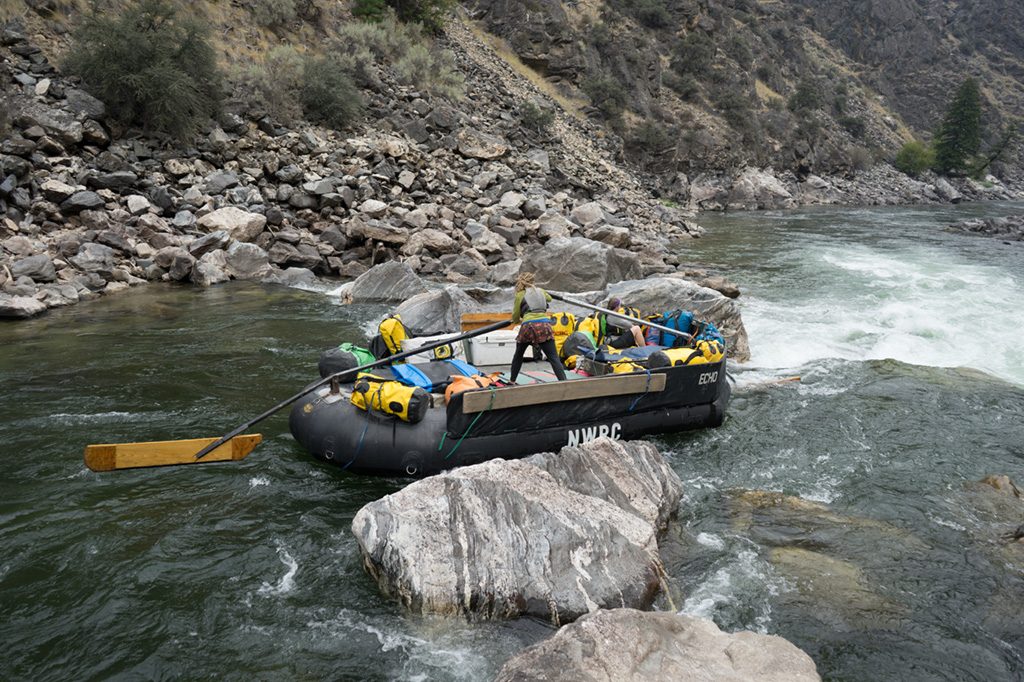
Audrey Gelhausen, sweep driver for Northwest Rafting Company, navigates “Old Toby” through Devil’s Tooth. Old Toby was a Shoshone guide for Lewis and Clark. Photo courtesy Northwest Rafting Company / Zach Collier
In 1968, the U.S. Congress passed The Wild and Scenic Rivers Act to “preserve certain rivers with outstanding natural, cultural and recreational values in a free-flowing condition for the enjoyment of present and future generations.” The Middle Fork of the Salmon River was designated a Wild and Scenic River that same year, celebrating its 50th anniversary in 2018. It’s also the only commercially run river that still relies on sweep boats.
As the clients and guides in kayaks and oar rafts swoop and splash their way through the dramatic river canyon and its plentiful rapids, stopping at gorgeous white sand beaches for lunch and soaking in one of the many hot springs that dot the Middle Fork’s banks, the sweep captain must keep his boat steadily in the main current. The faster a sweep boat is moving, the more control the captain has. Extremely unwieldy and sluggish in slack water, keeping the boat’s momentum moving downstream is key. Ned Perry, a sweep boat captain for OARS explains it this way: “In the Middle Fork’s 100 miles, there’s continuous current the entire time. That’s what allows the boats to maintain what we call ‘sweepage.’ When you’re moving they gain mobility. The faster you’re moving the more mobile you are.”
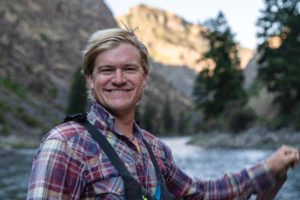
Sweep Boat captain Ned Perry
Alone at the helm, the sweep captain “saws” his sweep arms back and forth, using them as rudders and oars, being careful to avoid rocks and the large, gurgling, whirlpool filled eddies and their upstream currents that will leave the boat spinning in endless circles or crashing violently into a cliff wall. It’s a difficult job that requires strength, finesse, balance, and coordination, along with an intimate knowledge of the river and hydrodynamics. Every water level presents different challenges, and the stakes are always high. One miscalculation or mistake and all the gear, food, tents, sleeping bags, water and beer for six days and 30 people could be lost in the blink of an eye. It’s this unique and demanding skill set, along with the rest of the group’s dependence upon them, that make the sweep boat captain’s job such a prestigious and important one.
Modern sweep boats on the Middle Fork come in a variety of designs, but all maintain a few key components. They must be capable of carrying two to four tons of gear with a very shallow draft, while also being narrow and maneuverable enough to navigate tight, rock choked rapids during low water without getting stuck, and sturdy enough to survive the large and powerful breaking waves during high water.
Another critical aspect to sweep boats is their load balance. Every sweep captain has a different preference and technique when it comes to balancing their load, but they’re all extremely meticulous about it. In general, a sweep boat’s main source of control comes from the front sweep, so captains usually like to make sure that 60 percent of the gear weight is positioned towards the bow with the remaining 40 percent spread between the stern and side gunnels. It’s also interesting to note that as the float trip progresses food weight decreases, but since there are strict rules about packing out all food and wastethe actual overall weight of the boat stays about the same. It’s a joke common among sweep boat captains that what goes in, must come out.
Once the sweep boat captain reaches that night’s campsite his or her job is far from over. All that gear needs to be unloaded, unpacked, and set up so when the clients step off the rafts at the end of the day, their tents, beds and dry clothes are all there waiting for them. That’s not to mention a cold beer or glass of chilled wine.
It’s become part of the signature Middle Fork experience, and outfitters like Far and Away Adventures, based in Ketchum, have made an absolute art form out of creating the most comfortable campsites in the world in the middle of the wilderness without leaving a single thing behind. It’s all made possible by sweep boats and their captains, along with hard working guide crews, who not only make sure everyone makes it down the river safely and have a great time along the way, but are also gourmet chefs, janitors, dishwashers, bartenders, storytellers and musicians. No day on the Middle Fork is complete without a song or two around the campfire before bed, gazing up at the clear night sky filled with stars as a fire (even the ashes are kept and taken downstream on the sweep boat) crackles and the sound of the river rolling on by a few feet away creates the type of contentment and relaxation rarely found in today’s modern world.
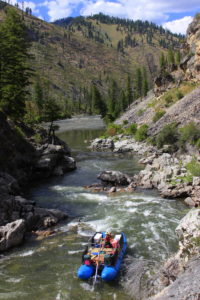
Chris Lentz enters the S-Turn at Pistol Creek
The next morning, as the guests are quietly sipping coffee or still sleeping, the sweep boat captain is orchestrating the guide crew like a skilled conductor as piles of gear get loaded on to the sweep and precisely arranged. Inside jokes and guffaws abound as the crew work together in a symphony of movement and efficiency honed over many seasons on the river working together. Before long, the sweep boat is launched and the captain, alone again with his thoughts, sets off for another day on the river. These are the moments sweep boat captains live for, as Perry explains quite eloquently: “That’s one of the best moments. The Middle Fork cuts right through the center of the Frank Church River of No Return Wilderness, which is the largest wilderness area in the lower 48 states. To be out there running a wild river in the middle of the wilderness, by yourself, and knowing what excitement you have ahead of you, I love that. There are times when you can get a little into your own head, but for the most part, it’s amazing. You get a lot of good time to reflect. A lot of times, I just stare up at the canyon walls and smile.”
There really is something mesmerizing about watching the sun on the canyon walls as it crawls slowly down them towards the rushing river, a place still incredibly wild and raw. Eagles and hawks soar above, mountain goats stand perched precariously along the vertical canyon walls, and large trout swim languidly beneath the surface as waterfalls drop down the cliffs and into the river. The daily stresses and worries of life in the modern world fade away and all that’s left is one beautiful moment, scenic vista and adrenaline pumping rapid after another. It’s no wonder so many sweep boat captains return to the Middle Fork every spring, year after year. It’s like Chris Lentz, a sweep boat captain and son of Far and Away owners who grew up on the river says, “There’s just no other job in the world like it.” 2


